Ehab AlBadawy
Jack
Get Large Language Models Ready to Speak: A Late-fusion Approach for Speech Generation
Oct 27, 2024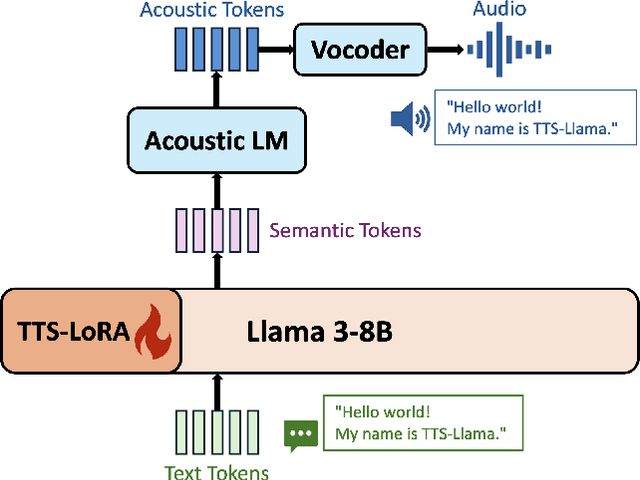
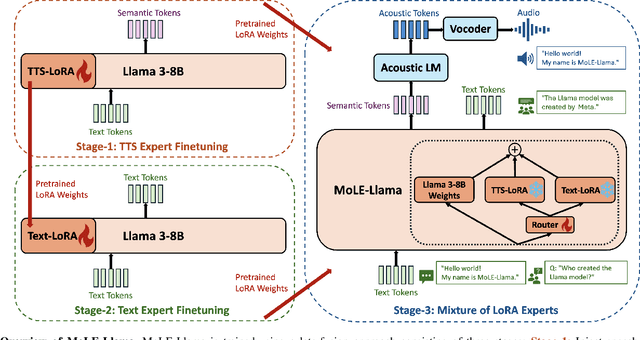
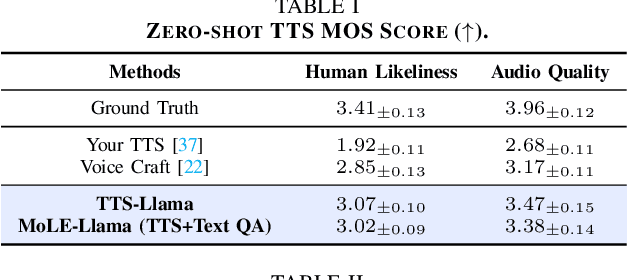
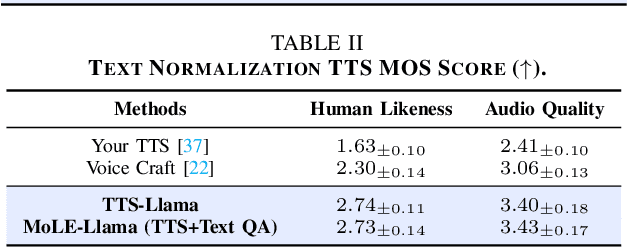
Abstract:Large language models (LLMs) have revolutionized natural language processing (NLP) with impressive performance across various text-based tasks. However, the extension of text-dominant LLMs to with speech generation tasks remains under-explored. In this work, we introduce a text-to-speech (TTS) system powered by a fine-tuned Llama model, named TTS-Llama, that achieves state-of-the-art speech synthesis performance. Building on TTS-Llama, we further propose MoLE-Llama, a text-and-speech multimodal LLM developed through purely late-fusion parameter-efficient fine-tuning (PEFT) and a mixture-of-expert architecture. Extensive empirical results demonstrate MoLE-Llama's competitive performance on both text-only question-answering (QA) and TTS tasks, mitigating catastrophic forgetting issue in either modality. Finally, we further explore MoLE-Llama in text-in-speech-out QA tasks, demonstrating its great potential as a multimodal dialog system capable of speech generation.
The Llama 3 Herd of Models
Jul 31, 2024Abstract:Modern artificial intelligence (AI) systems are powered by foundation models. This paper presents a new set of foundation models, called Llama 3. It is a herd of language models that natively support multilinguality, coding, reasoning, and tool usage. Our largest model is a dense Transformer with 405B parameters and a context window of up to 128K tokens. This paper presents an extensive empirical evaluation of Llama 3. We find that Llama 3 delivers comparable quality to leading language models such as GPT-4 on a plethora of tasks. We publicly release Llama 3, including pre-trained and post-trained versions of the 405B parameter language model and our Llama Guard 3 model for input and output safety. The paper also presents the results of experiments in which we integrate image, video, and speech capabilities into Llama 3 via a compositional approach. We observe this approach performs competitively with the state-of-the-art on image, video, and speech recognition tasks. The resulting models are not yet being broadly released as they are still under development.
Exposing AI-Synthesized Human Voices Using Neural Vocoder Artifacts
Feb 18, 2023Abstract:The advancements of AI-synthesized human voices have introduced a growing threat of impersonation and disinformation. It is therefore of practical importance to developdetection methods for synthetic human voices. This work proposes a new approach to detect synthetic human voices based on identifying artifacts of neural vocoders in audio signals. A neural vocoder is a specially designed neural network that synthesizes waveforms from temporal-frequency representations, e.g., mel-spectrograms. The neural vocoder is a core component in most DeepFake audio synthesis models. Hence the identification of neural vocoder processing implies that an audio sample may have been synthesized. To take advantage of the vocoder artifacts for synthetic human voice detection, we introduce a multi-task learning framework for a binary-class RawNet2 model that shares the front-end feature extractor with a vocoder identification module. We treat the vocoder identification as a pretext task to constrain the front-end feature extractor to focus on vocoder artifacts and provide discriminative features for the final binary classifier. Our experiments show that the improved RawNet2 model based on vocoder identification achieves an overall high classification performance on the binary task.
Inner Ensemble Nets
Jun 15, 2020
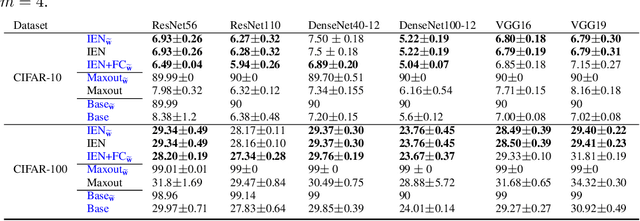

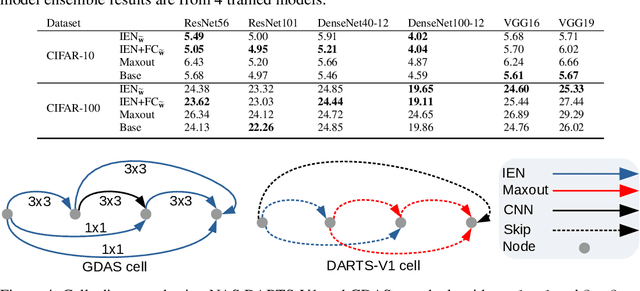
Abstract:We introduce Inner Ensemble Networks (IENs) which reduce the variance within the neural network itself without an increase in the model complexity. IENs utilize ensemble parameters during the training phase to reduce the network variance. While in the testing phase, these parameters are removed without a change in the enhanced performance. IENs reduce the variance of an ordinary deep model by a factor of $1/m^{L-1}$, where $m$ is the number of inner ensembles and $L$ is the depth of the model. Also, we show empirically and theoretically that IENs lead to a greater variance reduction in comparison with other similar approaches such as dropout and maxout. Our results show a decrease of error rates between 1.7\% and 17.3\% in comparison with an ordinary deep model. Code is available at \url{https://github.com/abduallahmohamed/inner_ensemble_nets.git}.
 Add to Chrome
Add to Chrome Add to Firefox
Add to Firefox Add to Edge
Add to Edge